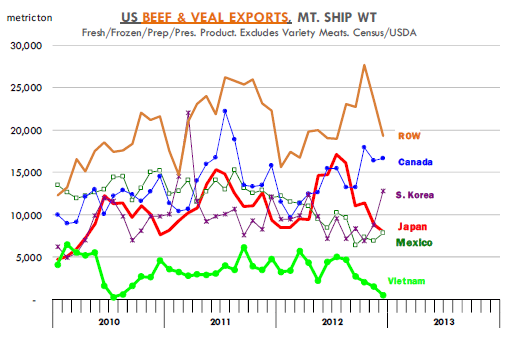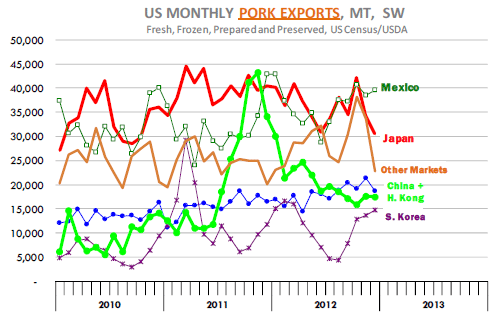



CME: Sharp Pullback in US Beef, Pork Exports in December
US - US beef, pork and poultry exports pulled back sharply in December even as the value of those exports continued to trend higher, write Steve Meyer and Len Steiner.Below is a brief recap of the latest export numbers:
Beef: Total US beef and veal exports (excludes variety meats)
in December were 65,239 MT, 15 per cent lower than in December
2011. For the year, exports of fresh/frozen/prepared US
beef and veal were 812,173 MT, down 12 per cent from the previous
year. The chart below outlines the trend in exports to
main markets for US beef and the rest of the world (ROW).

US
beef and veal exports in December were weak across the board.
Exports to Viet Nam declined by 4,317 MT (-90 per cent) from the previous
year. The cutback in exports to Viet Nam comes at a time when
China is purchasing more beef directly from Australia. US exports
to Hong Kong also have increased, with December shipments
up 4,637 MT (+145 per cent).
Beef inflation in China has accelerated
in recent months, leading to increased purchases in world
markets.
US beef exports to Japan declined steadily in the second
half of the year and were about 1 per cent lower for the year. December
shipments to Japan were down 1,370 MT (-15 per cent). Some believe the
decline is due to Japanese buyers pulling back on orders expecting
the Japanese government to relax cattle age requirements for US
beef. While this is possible, we think that the dramatic decline in
the value of the Japanese currency is a more likely culprit. Japanese
purchases of US pork also were down sharply in November
and December.
December US beef exports to Russia were almost
non-existent, down 97 per cent from the previous year. The loss
of the Russian market is significant for both beef and pork. In
2012, US beef and veal exports to Russia were 49,146 MT or 6 per cent of
overall US beef exports. Russian officials so far have shown little
indication that they are willing to discuss the issue of ractopamine
use in livestock production.
With more beef available from Brazil,
and the willingness of Brazilian authorities to implement a program
to test for ractopamine, Russia appears confident that it can
source most of its needs from Brazil, Uruguay and Australia, with
no need for US beef in 2013. If so, the loss of the Russian market
will offset some of the gains expected to be made in exports to Japan.
We think Japan shipments will increase in the short term as
there is some pent up demand for specific cuts. However, the increase
in exports to Japan may not be as large as some think given
that Japan already had access to eligible product in 2012 but was
limited by high US prices and more competitive offers from Australia.
Pork: Total exports of fresh/frozen/prepared pork in December
were 143,772 MT, down 22,011 MT (-13 per cent) from a year ago. For
the year, total US exports of fresh/frozen/prepared pork were
1.811 million MT, 3.3 per cent higher than a year ago and the largest amount of pork ever exported.
Japan remains one of the top markets
for US pork but shipments in December were disappointing,
down 24.4 per cent from the previous year. For the year, total US pork
shipments to Japan were 432,974 MT, down 9.4 per cent from a year ago.
The more worrying issue going forward is the prospect of shipments
to Russia. Between January and November 2012, Russia
purchased 89,570 MT of US pork or 5.3 per cent of all US pork exports.
In December, exports to Russia were just 664 MT and will likely
be down to zero in January and February of 2013. Pork exports
to North America remain strong, with Mexico up 15.5 per cent for the
year and Canada up 16.2 per cent. On the other hand, for the year shipments
to S. Korea were down 10.3 per cent and China down 8.7 per cent.









